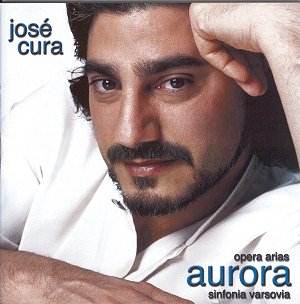Although the post-Three Tenors generation has still
to produce a universally adulated figure able to fill the football stadiums
of the world, the claims of José Cura are quite high. His is a
strong baritonal tenor – nearer to Domingo than to Pavarotti, therefore
– and it is the sort of tenor voice people like to hear, ringing, vibrant
and reliable, right up to a high-quality top C. Moreover he phrases musically
and naturally. Hear him in the Canción a la Bandera which
opens and closes this programme and his qualities are evident (example
1: track 1 from beginning). He also arouses our curiosity about the opera
itself. Hector Panizza is that same Ettore Panizza remembered as a conductor
for his fiery interpretations of Italian operas at the Metropolitan in
the 1930s, some of which have been transferred to CD.
You will also notice an occasional tendency to approach
notes from below; this habit is certainly irritating when he tries to
be soft and honeyed, as in "Quando le sere al placido" from
Luisa Miller (example 2: track 4 from 1’ 43"); the second stanza
of this aria goes rather better. On the other hand, very often this
habit is held sufficiently in check; "O Paradiso", from "L’Africana"
(the Italian version is used) can seem an open invitation to such treatment
but is actually sung very well. Here, however, with so many famous versions
in our ears, it has to be admitted that he brings no very special gifts
of interpretation or communication to the task. The phrase towards the
end "O nuovo mondo" carries no great enthusiasm or wonder,
it’s just sung. Another famous aria, "Cielo e mar" has the
phrase immediately following the opening words rather inelegantly managed
(both times round), though the rest is mostly fine (example 3: track
7, from 2’ 40"). Nor do I find a great deal of stylistic variation
between the different composers. Bellini is sung rather as Italian tenors
used to sing him; strong and beefy, like a precursor of Verdi. Alfredo
Kraus taught us that there are other ways. The interpretations become
increasingly satisfying as the programme moves forward chronologically,
therefore, and he convinces us that Giordano’s virtually forgotten Siberia
might be worth investigating.
Singers who conduct their own accompaniments are rare,
Herbert Handt being the only case that comes to mind (yes, I know Placido
Domingo conducts, but I think I’m right in saying that he doesn’t conduct
and sing at the same time). I should have thought that the movements
required for conducting would interfere with the balance of the body
and the control of the diaphragm required for singing, but they don’t
seem to. As to the success of the operation, the Siberia Prelude
demonstrates that Cura certainly can conduct. The advantages lie in
the punctuality of the accompaniment – a singer is unlikely to plod
along half a beat behind himself as some conductors do – but I also
feel, as in the case of concerto soloists who conduct as well, that
there is the loss of that dialogue between intelligent musical minds
which can take place when the conductor/soloist mix is right. The presence
of a fine conductor might have added a dimension to the interpretations.
In spite of my grumbles there is much to be enjoyed
here; but it would be idle to pretend that the most famous arias have
not been interpreted more memorably. We are informed that the recital
"is a selection of part of the repertoire of José Cura that
has never been recorded. No stylistic association coordinates the choice
of the arias". In truth this modest disclaimer was hardly necessary;
the programme works as well as programmes of opera extracts usually
do. The bonus track is a rather confusing affair and of little interest.
The recording is very good. Notes are limited to a personal comment
on the Panizza aria by Cura and some brief comments on Aurora
by Panizza himself. There are no texts except for the Panizza, which
is also translated into English and German, and the titles are as given
above, rather than the first line of the aria, which is how the pieces
are usually known (and as I have referred to them in the text).
Christopher Howell

